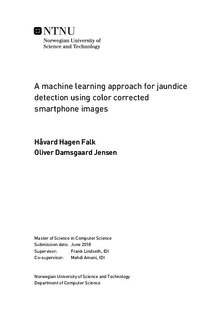A machine learning approach for jaundice detection using color corrected smartphone images
Master thesis
Permanent lenke
http://hdl.handle.net/11250/2566507Utgivelsesdato
2018Metadata
Vis full innførselSamlinger
Sammendrag
Neonatal jaundice and the associated yellow skin discoloration is caused by hyperbilirubinemia, a condition in which there is too much bilirubin in the blood. In 2010, the failure to treat jaundice resulted in 114,000 avoidable infant deaths and 75,000 children with brain dysfunction worldwide. Studies have found hyperbilirubinemia to be one of the top three causes of death among newborns in sub-Saharan Africa, and affordable jaundice detection technologies are urgently needed.
Transcutaneous bilirubinometers are robust screening methods commonly used by the medical community, but the price tag limits their widespread availability. Using smartphone cameras to capture skin induced color values, we create a low-cost alternative to expensive bilirubinometers. Through computer vision and deep learning, the final fully-connected feed-forward neural network achieves competitive results compared to Dräger JM-103, a state-of-the-art bilirubinometer. In the critical cases where treatment is required, the neural network even outperforms Dräger JM-103, resulting in 75% fewer false negative predictions.
Contrary to the transcutaneous bilirubinometers, the proposed solution relies on images, where light sources and camera sensors drastically impact the skin information. To make images illumination and camera independent, we propose a novel approach for color correction, the Gaussian process regression (GPR), a machine learning model that adapts to environmental variables. The results show that the GPR achieves equal results to state-of-the-art color correction techniques, while also creating more general models.
